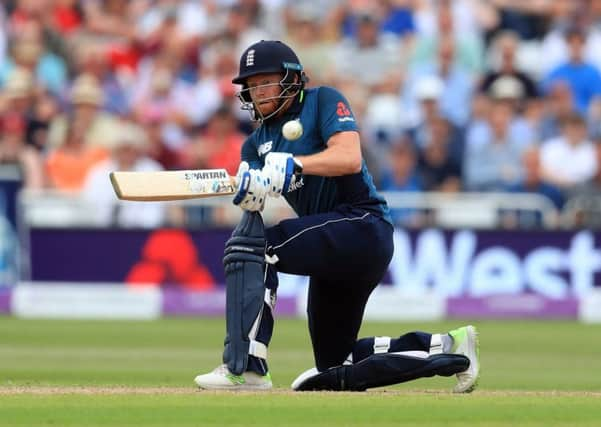Chris Waters: Brilliant batsmen making most of scales tipping in their favour


This month alone, batting records have been tumbling like ninepins amid a veritable blizzard of run-scoring feats.
First, New Zealand posted the highest total in a women’s one-day international – 490-4 against Ireland in Dublin, beating their own long-standing world record of 455-5.
Advertisement
Hide AdAdvertisement
Hide AdLater in the same series, Amelia Kerr, the 17-year-old New Zealander, hit a women’s world record 232 not out before taking five wickets to cap a remarkable individual performance.
A few days after that, the England men broke their own world record of 444-3 for the highest total scored in a one-day international, striking 481-6 against Australia at Trent Bridge.
They even came off the field slightly disappointed not to have become the first team to score 500 – the ODI equivalent of the four-minute mile – after breathtaking assaults by Yorkshire’s Jonny Bairstow, Alex Hales, Jason Roy and Eoin Morgan had utterly dismantled Australia’s attack.
The very next day, the women’s Twenty20 international record total fell twice at Taunton, where New Zealand scored 216-1 against South Africa before England made 250-3 against the same opponents.
Advertisement
Hide AdAdvertisement
Hide AdEverywhere we have looked, June has brought forth so many fours and sixes that it has been practically impossible to keep track of them all, with some of the bowling analyses suffered in consequence so horrifying that they are best viewed from behind the sofa with one eye shut.
But the question remains: is the balance right?
Is it good for the game that scores of 400-plus in men’s one-day international cricket, for example, are becoming increasingly common, with eight having been achieved since the start of 2015 alone?
On balance, I would suggest that the scales, although undeniably weighted towards batsmen, are not detrimentally tipped in that direction.
Granted, bowlers have to contend with heavier bats, flatter pitches, shorter boundaries, fielding restrictions that limit the number of men that can be placed on the boundary, balls that offer little movement, and so on, but that does not mean that a batting unit simply has to turn up to take ruthless advantage.
Advertisement
Hide AdAdvertisement
Hide AdIndeed, some of the shots played by Bairstow et al against Australia at Trent Bridge were some of the most astonishingly powerful shots that the game can have seen, played by exceptionally gifted players given licence to express themselves in an era in which T20 has had a knock-on effect on what is now possible in the 50-over game.
It is an injustice to those individuals to say that England only got to that score because the pitch was flat, the boundaries short, and so on, and to infer that any team could have routinely taken such devastating advantage of an admittedly under-strength Australia side.
On the contrary, I believe that you must give the utmost credit to the batsmen concerned, who have helped to raise the bar and extend the boundaries of what is now possible.
Of course, not everyone agrees that the balance is right, and no less a voice than that of Jimmy Anderson, England’s leading Test match wicket-taker, believes it is now too much of a batsman’s game.
Advertisement
Hide AdAdvertisement
Hide Ad“When I went to watch cricket as a kid, the things that stuck out are those moments of brilliance – a catch, a yorker, a six,” he said on Test Match Special.
“I can’t remember half of the sixes that were hit at Trent Bridge; it just becomes a blur.”
Anderson undoubtedly has a point, as do those who feel that the game needs to find a white ball that swings more at the start and who say that the use of two balls per innings needs to be scrapped, thus giving the old ball a chance to reverse swing.
That would certainly be an effective way of bringing bowlers back into the game and also ensuring that children still grow up wanting to be bowlers – not simply batsmen intent on smashing bowlers the way of the dodo.
Advertisement
Hide AdAdvertisement
Hide AdAt the same time, cricket needs to ask itself: what does it want?
For example, a few years ago I had personally become so tired of 50-over cricket that I was among the many who wanted it scrapped – the middle overs, in particular, were so dull that they made ditchwater seem positively interesting.
Now I genuinely look forward to watching England play ODIs, as did those who flocked to Trent Bridge to see them make history.
In the final analysis, no matter how much the game favours batsmen, sides do not score 481 every week (it is still very much the exception rather than the norm), and good bowlers will – and still do – find a way.